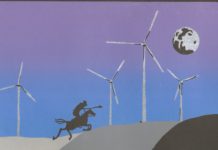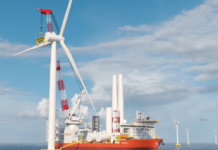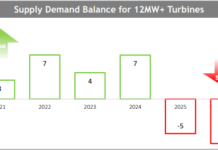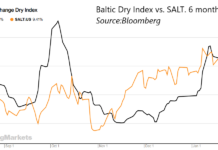Some of you may remember an article I wrote last March about a small Canadian wind turbine maker called AAER Inc (AAERF.PK or AAE.V). In fact, I got a few emails from readers informing me that they’d bought the stock following my article and that they were happy with its performance. The following chart traces the stock’s performance between the date of the article (March 7, 2007) and last Friday (May 2, 2008):  Since I wrote this article many things have changed with AAER. The Katabatic contract, which is what attracted my attention initially, is no longer in effect. AAER has nonetheless forged ahead and entered into a number of supply agreements to get its hands on turbine components, not the least of which is with American Superconductor (NASDAQ:AMSC), a stock many wind investors have on their radars (or in their portfolio). SkyPower, a Canadian wind heavyweight and affiliate of Lehman Brothers, bought about 20% of AAER’s equity in the fall of ’07. In fact, it is formally Lehman Brothers Inc. that owns the stake. Then, only a few weeks ago, the company announced another round of equity financing through a bought deal at C$1.20/shr, for a total of C$7.5m (US$7.82m). Finally, the company managed to sell a few of its turbines in Canada, the US and France. Overall, AAER looks it is getting the right things done. However, the stock’s latest run was tied to one event in particular. The Hydro-Quebec Bid AAER’s partnership with SkyPower as well as another partnership with TransCanada Energy Ltd appeared to position AAER very well for the much-awaited Hydro-Quebec request for proposal (RFP) for wind power. This RFP, calling for the installation of 2,000 MW of wind power in the Canadian province of Quebec, represents the single largest block of wind power contracts to be awarded anywhere in North America to date. Under these contracts, Hydro-Quebec, the state-controlled power utility, buys the electricity under a 20-year agreement from private sector projects at a rate of C$0.087/kWh. Consortia of developers and turbine makers were invited to bid projects into RFP.The call attracted a fair deal of attention with 66 bids totaling 7722.2 MW – significantly more than the 2,000 needed. Through its partnerships with SkyPower and TransCanada, both of which submitted bids into the RFP, AAER believed it had a serious shot at jumpstarting its business. AAER is headquartered in the province of Quebec, and local assembly of the turbines as well as local economic development considerations more generally were key criteria in judging the bids (along with factors such as costs, reliability of turbines, ability to manage community relations, etc). Moreover, both partners have strong reputations in the Canadian wind market and SkyPower is already active in Quebec. In both cases, the consortia appeared very well positioned to be selected and AAER (and many of its shareholders) saw this as: a) an opportunity to fill the order book in the near-term and b) a chance to establish its reputation in the North American marketplace for the long run by getting a few hundred MWs of turbines going in the real world. If this was successful, it could bolster AAER’s assault on a North American marketplace in dire need of turbines and that is currently being underserved by the incumbents. The winners were announced on Monday (May 5) at 11:15 am and the AAER consortia were not a part of them. The stock immediately collapsed, so much so that Canadian market regulators suspended trading and expunged a bunch of trades because the news conference was in French only and the info was not disseminated to American and English Canadian investors at the same time as to French Canadian ones. When trading reopened on Tuesday morning, the share price immediately tumbled and found resistance for most of the day at around $0.60.
Since I wrote this article many things have changed with AAER. The Katabatic contract, which is what attracted my attention initially, is no longer in effect. AAER has nonetheless forged ahead and entered into a number of supply agreements to get its hands on turbine components, not the least of which is with American Superconductor (NASDAQ:AMSC), a stock many wind investors have on their radars (or in their portfolio). SkyPower, a Canadian wind heavyweight and affiliate of Lehman Brothers, bought about 20% of AAER’s equity in the fall of ’07. In fact, it is formally Lehman Brothers Inc. that owns the stake. Then, only a few weeks ago, the company announced another round of equity financing through a bought deal at C$1.20/shr, for a total of C$7.5m (US$7.82m). Finally, the company managed to sell a few of its turbines in Canada, the US and France. Overall, AAER looks it is getting the right things done. However, the stock’s latest run was tied to one event in particular. The Hydro-Quebec Bid AAER’s partnership with SkyPower as well as another partnership with TransCanada Energy Ltd appeared to position AAER very well for the much-awaited Hydro-Quebec request for proposal (RFP) for wind power. This RFP, calling for the installation of 2,000 MW of wind power in the Canadian province of Quebec, represents the single largest block of wind power contracts to be awarded anywhere in North America to date. Under these contracts, Hydro-Quebec, the state-controlled power utility, buys the electricity under a 20-year agreement from private sector projects at a rate of C$0.087/kWh. Consortia of developers and turbine makers were invited to bid projects into RFP.The call attracted a fair deal of attention with 66 bids totaling 7722.2 MW – significantly more than the 2,000 needed. Through its partnerships with SkyPower and TransCanada, both of which submitted bids into the RFP, AAER believed it had a serious shot at jumpstarting its business. AAER is headquartered in the province of Quebec, and local assembly of the turbines as well as local economic development considerations more generally were key criteria in judging the bids (along with factors such as costs, reliability of turbines, ability to manage community relations, etc). Moreover, both partners have strong reputations in the Canadian wind market and SkyPower is already active in Quebec. In both cases, the consortia appeared very well positioned to be selected and AAER (and many of its shareholders) saw this as: a) an opportunity to fill the order book in the near-term and b) a chance to establish its reputation in the North American marketplace for the long run by getting a few hundred MWs of turbines going in the real world. If this was successful, it could bolster AAER’s assault on a North American marketplace in dire need of turbines and that is currently being underserved by the incumbents. The winners were announced on Monday (May 5) at 11:15 am and the AAER consortia were not a part of them. The stock immediately collapsed, so much so that Canadian market regulators suspended trading and expunged a bunch of trades because the news conference was in French only and the info was not disseminated to American and English Canadian investors at the same time as to French Canadian ones. When trading reopened on Tuesday morning, the share price immediately tumbled and found resistance for most of the day at around $0.60.  In the end, two turbine makers were selected to provide all of the 2,000 MW: Enercon and REPower (RPWSF.PK) What’s Next? As pointed out in the article linked to initially, I entered my positions in AAER at C$0.39 and C$0.38. In early January, I got the majority of the dollar value of my initial investment out at C$1.15. On the morning of the announcement, I wrestled with getting another chunk of my position out at C$1.80, but ultimately decided not to budge – this was a gamble and I lost it. However, at around $0.39 with the information that was available in March 2007, this looked to me more like a high-risk value play than like a gamble. Reading through an AAER investor discussion board Tuesday afternoon, I came across the usual mix of anger and amazement. One fellow claimed he and his family had lost $70,000 (not sure whether it has been realized or not). Others, who had pulled the trigger right on time after the announcement and had still been able to get out with a fat profit, saw their trades expunged by the regulator and were later forced to accept significantly lower bids. This episode speaks to the risks of investing based on a story alone. The AAER story sounded too good to pass to many people, and few folks bothered to figure out what the firm was worth without those Hydro-Quebec contracts. Beyond just a story, generally upward movements in this stock in recent weeks were driven by a single high-probability event, and this is where gambling instincts take over rational analysis. For me, the main lesson from something like this is that it reinforced the importance of risk management. Risk is inherent to investing, and it is important to take at least some steps toward managing it. In this case, I applied the simplest possible form of risk management: I pulled my initial money out. The only cost of doing so, unlike using derivatives, is the opportunity cost of potential future capital gains – so it’s in effect free. This was mentally difficult to do in this case, as it often is, and I am actually guilty of not pulling any money out the first time the stock peaked in October and November 2007. Like many other people, when I did a rough mental computation of what I believed to be the probability of AAER getting at least one of the contracts, I felt I would be surrendering a lot of upside by pulling out too early. Many pure play alt energy stocks are either unprofitable or are profitable but trade at very high multiples. Like AAER, many of them also receive rich valuations based on nothing more than a good story. There is therefore a good chance that pure-play alt energy stocks will add at least some risk to a portfolio. If calls and puts aren’t for you, a good idea is to set targets at which to exit part of a position to protect gain.
In the end, two turbine makers were selected to provide all of the 2,000 MW: Enercon and REPower (RPWSF.PK) What’s Next? As pointed out in the article linked to initially, I entered my positions in AAER at C$0.39 and C$0.38. In early January, I got the majority of the dollar value of my initial investment out at C$1.15. On the morning of the announcement, I wrestled with getting another chunk of my position out at C$1.80, but ultimately decided not to budge – this was a gamble and I lost it. However, at around $0.39 with the information that was available in March 2007, this looked to me more like a high-risk value play than like a gamble. Reading through an AAER investor discussion board Tuesday afternoon, I came across the usual mix of anger and amazement. One fellow claimed he and his family had lost $70,000 (not sure whether it has been realized or not). Others, who had pulled the trigger right on time after the announcement and had still been able to get out with a fat profit, saw their trades expunged by the regulator and were later forced to accept significantly lower bids. This episode speaks to the risks of investing based on a story alone. The AAER story sounded too good to pass to many people, and few folks bothered to figure out what the firm was worth without those Hydro-Quebec contracts. Beyond just a story, generally upward movements in this stock in recent weeks were driven by a single high-probability event, and this is where gambling instincts take over rational analysis. For me, the main lesson from something like this is that it reinforced the importance of risk management. Risk is inherent to investing, and it is important to take at least some steps toward managing it. In this case, I applied the simplest possible form of risk management: I pulled my initial money out. The only cost of doing so, unlike using derivatives, is the opportunity cost of potential future capital gains – so it’s in effect free. This was mentally difficult to do in this case, as it often is, and I am actually guilty of not pulling any money out the first time the stock peaked in October and November 2007. Like many other people, when I did a rough mental computation of what I believed to be the probability of AAER getting at least one of the contracts, I felt I would be surrendering a lot of upside by pulling out too early. Many pure play alt energy stocks are either unprofitable or are profitable but trade at very high multiples. Like AAER, many of them also receive rich valuations based on nothing more than a good story. There is therefore a good chance that pure-play alt energy stocks will add at least some risk to a portfolio. If calls and puts aren’t for you, a good idea is to set targets at which to exit part of a position to protect gain.
The more something looks like a gamble rather than an investment, the more disciplined one needs to be about this and the lower the threshold should be. As for AAER, I’m hanging in there for now. I like some of the progress that’s been made to date, and I think their strategy of targeting community-based projects under 50MW, which are the projects that are having the toughest time getting any attention at all from the turbine majors, could pay off. There is no doubt that this firm’s prospects look a lot less bright than they did a few days ago, and the C$7.5 m financing discussed above could be in jeopardy (or at least may be renegotiated). With the momentum crowd now gone, I don’t expect this stock to shoot up again for an appreciable period of time. If you’re still holding AAER and are not sure what to do, the question you have to ask yourself is: do I really want to own this business or was I just gambling? In the latter case, better get out. UPDATE (May 7): As predicted, AAER’s financing was re-negotiated and will take place at C$0.50/shr Vs. C$1.20/shr initially…ouch. UPDATE (May 23): In the latest AMF bulletin (the AMF is Quebec’s financial markets regulator), dated May 23rd, it came out that Lehman Brothers had divested about 39% of its position in AAER through 24 transactions between May 5 and 6. Lehman’s holding now stands at 8.53 million shares, or ~10% of shares o/s. On the upside, the CEO, Dave Gagnon, purchased an extra 16,000 shares at C$0.45 on May 21. He currently holds about 11% of shares o/s.
DISCLOSURE: The author is long AAER
DISCLAIMER: I am not a registered investment advisor. The information and trades that I provide here are for informational purposes only and are not a solicitation to buy or sell any of these securities. Investing involves substantial risk and you should evaluate your own risk levels before you make any investment. Past results are not an indication of future performance. Please take the time to read the full disclaimer here.







